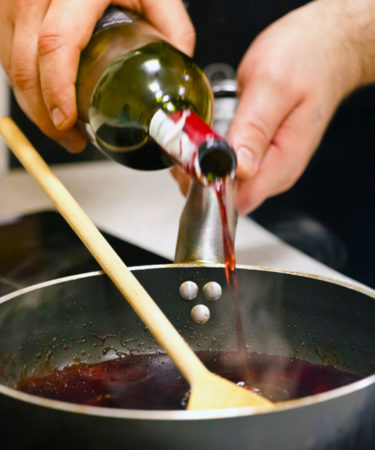There’s an age-old adage about cooking with wine: “If you wouldn’t drink it, don’t cook with it.” It’s a nice idea in theory, but one that doesn’t always make practical or financial sense.
Can you cook with wines that have been opened for over a week? The short answer is yes. But, as with everything in wine, the guidelines are nuanced. Here’s how to know if you can and should cook with an open bottle of wine.
Cooking With Wine
Let’s say you have a bottle of wine that has been kept covered with a stopper or its original cork for 10 days. It would taste off if you poured it in a cup, but its signs of age would be undetectable in a stew, sauce, or reduction.
This is because, during cooking, a wine’s flavor changes. In addition to losing alcohol content, the wine’s fruity characteristics get lost in the process. What wines do impart are four key characteristics: acidity, sweetness, and tannins, as well as kind of generic, “wine-y” flavor.
What Not to Use
So what about corked and spoiled wines? You certainly wouldn’t want to drink either of them, but can they, too, be used for cooking?
Sadly, no. If a wine contains a flaw like cork taint or volatile acidity, these characteristics are imparted to the dish. Cork taint is caused by a chemical contaminant, 2,4,6-trichloroanisole, or TCA. The contamination usually occurs at some point during the winemaking process, from fermentation to bottling. TCA-tainted, or “corked,” wines have a strong, moldy odor, like damp newspaper or wet dog. The taint is piercing and pungent and causes a complete loss of all fruit character.
Once tainted with TCA, there are no ways to remove its effect from wine. Unlike fruit notes, cooking does not remove cork taint, though some argue it can significantly reduce it.
But the problem with cork taint is that people perceive it in different ways. Some are hypersensitive to the odor, so even if you think you might have cooked it out of a sauce or masked it with other flavors, your dinner guests might think otherwise.
The same is true for wines displaying volatile acidity, or higher than normal levels of acetic acid. These wines display notes of nail polish remover, vinegar, and model-airplane glue. While your recipe may or may not call for the addition of vinegar, nail polish remover and model-airplane glue are unlikely to be found on any ingredients list.
The Last Pour
There are other, more minor flaws with which the inclusion of the wine can be left to the chef’s discretion. While some articles advise against it, this writer is more than happy to use the last third of a bottle that didn’t quite get finished during the weekend for a midweek stew. Granted, the wine must be stored correctly — ideally in the refrigerator, in a sealed bottle, with minimum exposure to oxygen — but there’s absolutely no harm in cooking with a slightly oxidized wine that is no longer fit for drinking.
Anecdotally speaking, as a former professional chef, this writer can confirm that in professional kitchens, where profit margins are super-fine, chefs almost always stick to cheap table wine or cooking wine. Yet, no matter how tough the evening’s service might have gone, neither of these would be considered a suitable post-service refreshment.
